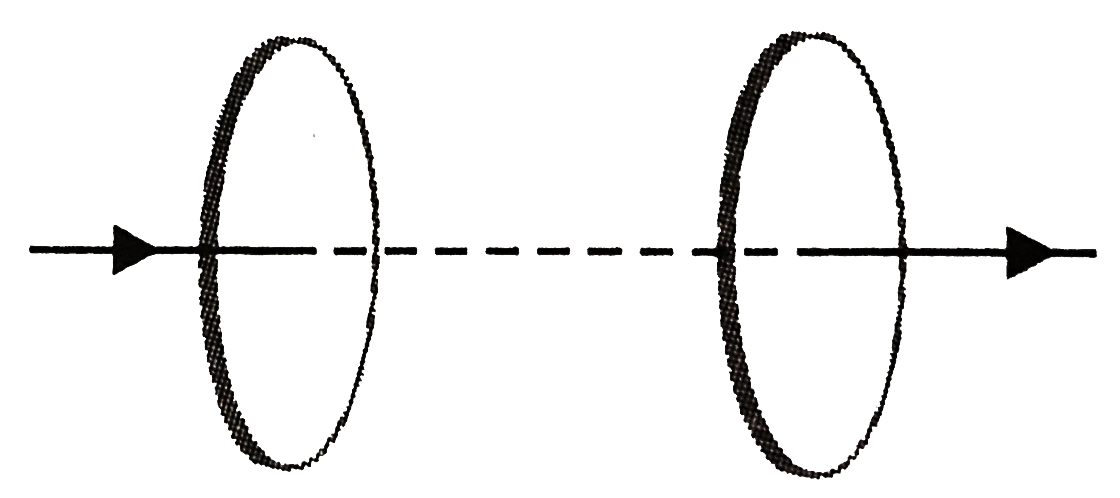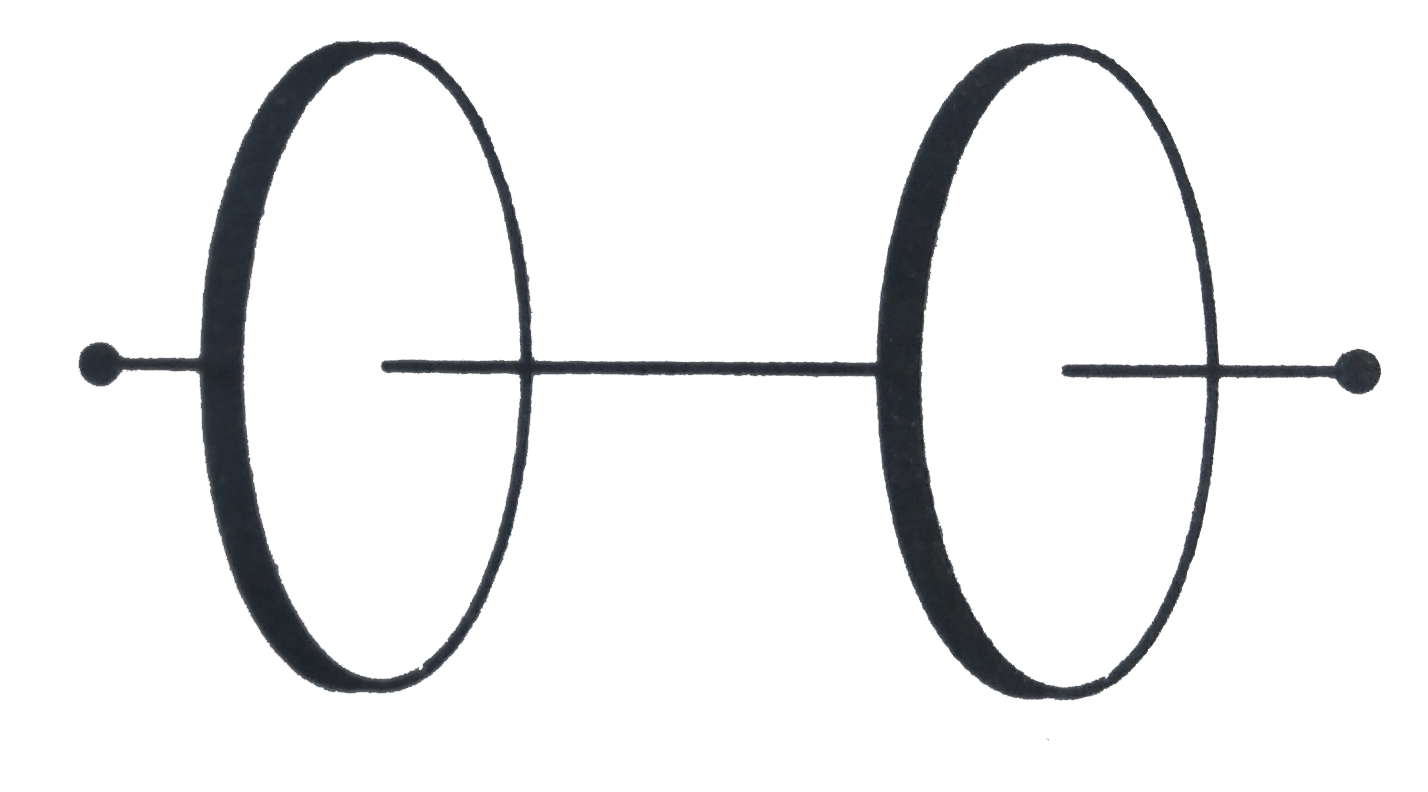Figure shown a capacitor made of two circular plates each of radius 12 cm and separated by 5 mm. The capacitor is being charged by an external source. The charging current is constant and equal to 0.15 A.
(a) Calculate the capacitance and the rate of change of potential difference across the plates.
(b) Obtain the displacement current across the plates.
(c) If Kirchhoff's junction rule valid at each plate of the capacitor ?
(ε0=8.85×10−12C2N−1m−2)

(a) C=ε0Ad=ε0(πr2)d
=(8.88×10−12)(3.14×(12×10=−2)2)(5×10−3)
=80.1×10−12F
Also, I=dqdt=ddtCV=CdVdt⇒dVdt=IC
=0.1580.1×10−12=1.87×109Vs−1
(b) Ip=I=0.15A
(c) 
Junction rule is valid at each plate as incoming current equals outgoing current.
Topper's Solved these Questions
- ELECTROMAGNETIC WAVESBOOK - MTG GUIDECHAPTER - ELECTROMAGNETIC WAVESEXERCISE - NEET CAFÉ (TOPICWISE PRACTICE QUESTIONS)
50 Videos
- ELECTROMAGNETIC WAVESBOOK - MTG GUIDECHAPTER - ELECTROMAGNETIC WAVESEXERCISE - CHECK YOUR NEET VITALS
25 Videos
- ELECTROMAGNETIC INDUCTION AND ALTERNATING CURRENTSBOOK - MTG GUIDECHAPTER - ELECTROMAGNETIC INDUCTION AND ALTERNATING CURRENTSEXERCISE - AIPMT/NEET MCQS
31 Videos
- ELECTRONIC DEVICESBOOK - MTG GUIDECHAPTER - ELECTRONIC DEVICESEXERCISE - AIPMT/NEET (MCQs)
42 Videos
Similar Questions
Fig. shows a capacitor made of two circular plates each of radius 12 cm and separated by 5.0mm. The capacitor is being charged by an external source (not shown in the figure). The charging current is constant and equal to 0.15A.
(a) Calculate the capacitance and the rate of change of potential difference between the plates.
(b) Obtain the displacement current across the plates.
(c) Is Kirchhoff's first rule valid at each plate of the capacitor ? Explain.

View SolutionFig. shows a capacitor made of two circular plates each of radius 12 cm and separated by 5.0mm. The capacitor is being charged by an external source (not shown in the figure). The charging current is constant and equal to 0.15A.
(a) Calculate the capacitance and the rate of change of potential difference between the plates.
(b) Obtain the displacement current across the plates.
(c) Is Kirchhoff's first rule valid at each plate of the capacitor ? Explain.

View Solution
Knowledge Check
A capacitor made of two circular plates each of radius 12 cm and separated by 5 mm. The capacitor is being charged by an external source. The charging current is constant and equal to 0.15 A. The capacitance of the parallel plate capacitor is
 A40 pFB45 pFC70 pFD80 pF
A40 pFB45 pFC70 pFD80 pFA capacitor made of two circular plates each of radius 12 cm and separated by 5 cm. The capacitor is being charged by an external source. The charging current is constant and equal to 0.15 A. The capacitance of the parallel plate capacitor is
 A40 pFB45 pFC70 pFD80 pF
A40 pFB45 pFC70 pFD80 pFA parallel plate capacitor consists of two circular plates each of radius 12cm and separated by 5.0mm. The capacitor is being charge by an external source. The charging current is constant and is equal to 0.15 A. The rate of change of potential difference between the plate will be
A8.173×107Vs−1B7.817×108Vs−1C1.173×109Vc−1D3.781×1010Vs−1
A parallel plate capacitor made of two circular plates each of radius 10 cm and separated by 4.0mm. The capacitor is being charged by an external source. The charging current is constant and equal to 0.10A. Calculate (i) the capacitance (ii) the rate of change of potential difference between the plates (iii) the displacement current.
View SolutionFigure 8.01 shows a capacitor made of two circular plates each of radius 12 cm, and separated by 5.0 cm. The capacitor is being charged by an external source (not shown in the figure). The charging current is constant and equal to 0.15 A.
(a) Calculate the capacitance and the rate of charge of potential difference between the plates.
(b) Obtain the displacement current across the plates.
(c) Is Kirchhoff.s first rule (junction rule) valid at each plate of the capacitor? Explain.

View SolutionFigure shows a capacitor made of two circular plates each of radius 12cm, and separated by 5.0cm. the capacitor is being charged by an external source (not shown in the figure). The charging current is constant and equal to 0.15A
(a) Calcuate the capacitance and the rate of change of potential difference between the plates
(b) Obtain the displacement current across the plates
(c) Is kirchhoff's first rule(junction rule) vaild at each plate of the capacitor ? Explain.
 .
.
View SolutionFigure shows a capacitor made of two circular plates each of radius 12cm, and separated by 5.0cm. the capacitor is being charged by an external source (not shown in the figure). The charging current is constant and equal to 0.15A
(a) Calcuate the capacitance and the rate of change of potential difference between the plates
(b) Obtain the displacement current across the plates
(c) Is kirchhoff's first rule(junction rule) vaild at each plate of the capacitor ? Explain.
 .
.
View SolutionA capacitor consists of two circular plates each of radius 8.0 cm and separated by 3.0 mm. The capacitor is being charged by an external battery. The charging current is constant and is equal to 0.3 A. Calculate (i) capacitance of capacitor, (ii) the rate of change of potential difference across the plates of capacitor and (iii) the displacement current.
View Solution
